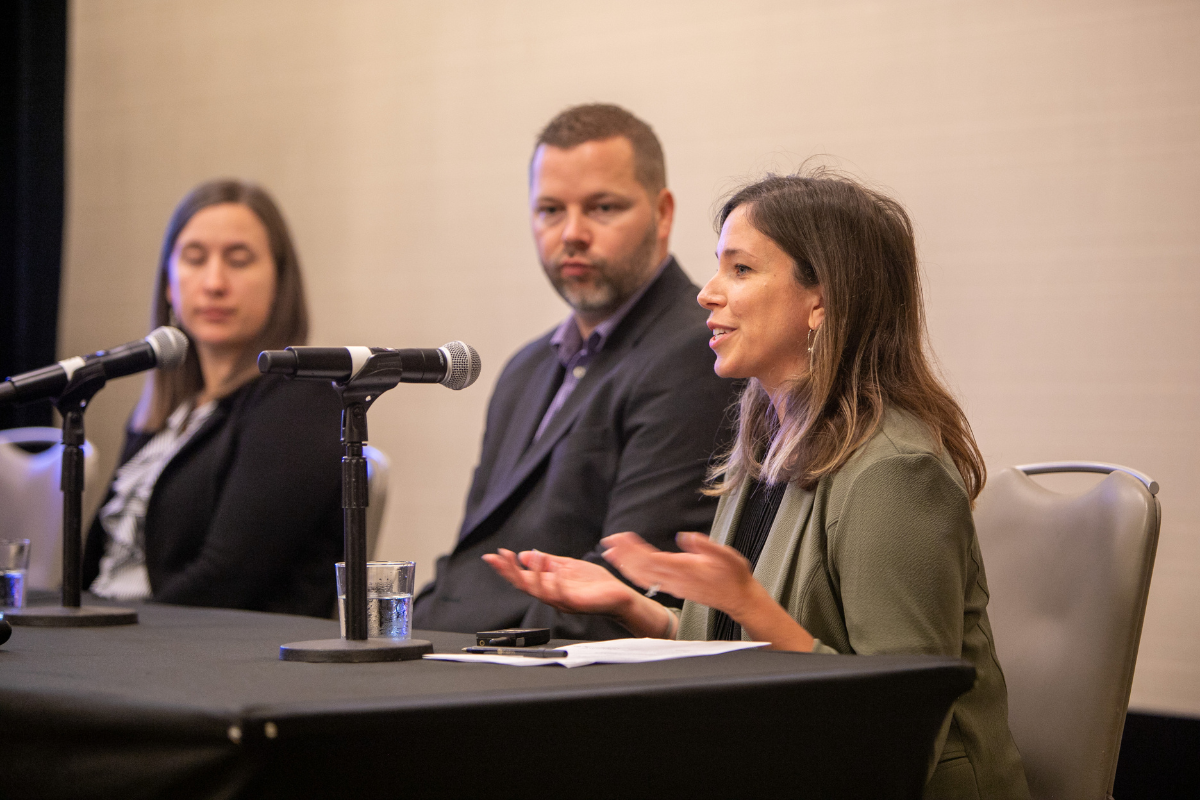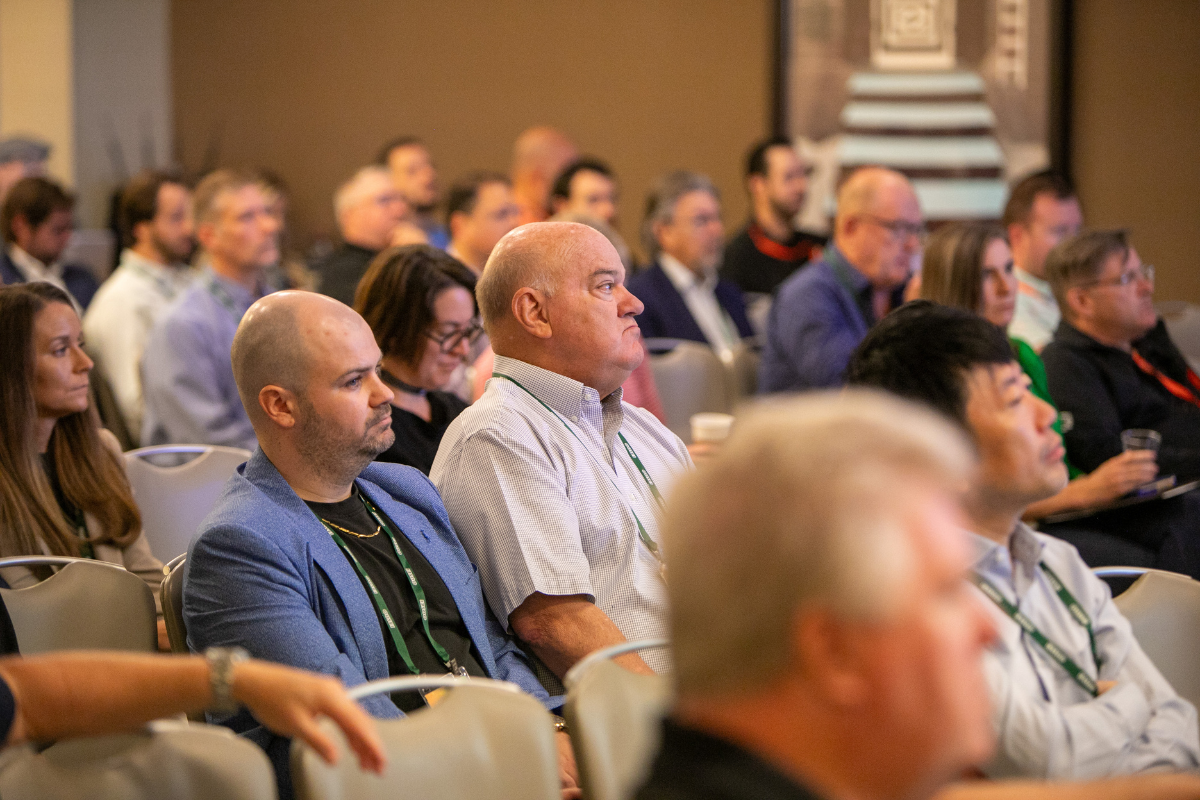
Natalie Betts with the Institute of Scrap Recycling Industries (ISRI) speaks on ESG at the 2023 E-Scrap and E-Reuse Conference in New Orleans. | Big Wave Productions/E-Scrap News
Recycling companies big and small can benefit from publicly sharing their environmental, social and governance strategies, no matter how complicated the process might seem at first.
At the 2023 E-Scrap and E-Reuse Conference held in New Orleans Sept. 18-20, industry experts gave advice on how to get started with environmental, social and governance (ESG) reports and why they matter for everyone.
The Sept. 19 session, “Leveraging Your ESG Expertise,” brought together as panelists Natalie Betts, assistant vice president of sustainability for the Institute of Scrap Recycling Industries (ISRI); Curt Greeno, president of Dynamic Lifecycle Innovations; and Naomi Manahan, senior operations program manager for Reverse Logistics Group Americas. Corey Dehmey, executive director of Sustainable Electronics Recycling International (SERI), moderated.
The idea of making ESG plans has been taking hold in the industry, the speakers agreed, and requests for such plans will only continue to rise.
Greeno said Dynamic’s sales team has seen the number of requests for proposals that contain ESG questions and requirements triple over the last two or three years. Manahan agreed, noting that “this is something that is no longer on the horizon. It is here.”
“It’s one of those things that you really should consider taking the time just a couple days a year, honestly, every year to discuss this stuff and lay out a framework for how you want to be best in class and a step above your competitors,” she said.
“All of this ESG work is an opportunity to come together with cross-functional teams to think about things with a slightly different lens than you have before and identify gains, not only for your customers or your employees, but for your business bottom line.”—Natalie Betts, Institute of Scrap Recycling Industries (ISRI)
Betts said she’s also seeing more government entities ask about ESG plans and standards along with the private sector.
“Maybe the largest customers are asking now, or maybe they’re asking but not requiring you to answer,” Betts said. “I think that’s going to change over time where you’re going to be required to answer and more and more questions are going to come in.”
Sitting down and laying out ESG goals can also help business overall, Betts added. Much of the environmental aspect of ESG focuses on emissions, and oftentimes finding ways to reduce emissions means running more efficiently, she said.
“All of this ESG work is an opportunity to come together with cross-functional teams to think about things with a slightly different lens than you have before and identify gains, not only for your customers or your employees, but for your business bottom line,” Betts said.
How to approach ESG
It can be intimidating to figure out where to begin with an ESG report, the panelists acknowledged, but starting small and looking at what’s already there can make it manageable.
Betts said if a recycler already has any kind of certification, they’ve likely “done some form of ESG reporting, just in a different language, a different way of presenting the data.”
“A lot of ESG is just a matter of data collection and having transparency about your operation,” she said. “So you probably already have the documents sitting in a drawer or in a file somewhere. You just need to put them in a different format.”
It can also help to look at other companies’ ESG reports and policies as a template, she added.

Attendees listen to speakers during the “Leveraging your ESG Expertise” session.
Manahan said Reverse Logistics Group (RLG) did its first internal report for the year 2021 and its first public report for calendar year 2022.
“It’s almost like learning a new language, and the real barrier to entry, in my opinion, is just understanding the definitions of everything, understanding how to write the report,” she said.
RLG’s public report is 11 pages long, because “you don’t need to make this complicated,” Manahan added.
“I like to tell people to just have a discussion, have a starting point,” she said. “It doesn’t need to be the same as an OEM that has millions of dollars to spend to make these beautifully polished sustainability reports. Just start with the basics.”
A good ESG plan not only captures what a business is already doing, Betts said, but also helps it grow, find new customers and reduce risk. ISRI is working to build a toolkit to help members make their own ESG reports that should be available at the end of the year, she added, along with a workshop series.
Deconstructing ESG
Breaking down the categories, governance is how the company is run and what its policies are, especially around transparency and accountability, Manahan said. Initial ESG reports likely won’t be about setting new policies, but laying out in writing what is already there, Greeno added. Dynamic issued its first ESG report in 2022.
“It’s not about going out and just trying to do a bunch of brand new things,” he said. “It’s really capturing the essence of what we’re doing already. We’re not trying to make new goals that don’t make sense for our business. It’s really our goals that are aligned with our business goals and our strategy. And then we just capture that as part of our ESG report.”
Social reporting can be tricker, as it lacks the quantitative metrics of the environmental aspect, but the recycling industry has plenty to report, the panelists noted. Betts said the best way to think about social was how a company impacts three levels of people – direct employees, vendors’ employees up and down the value chain, and then the community around the business.
Safety reporting would fall under social reporting, she suggested, and “I’m sure you all have safety programs and you probably even have safety data.”
Any work with local nonprofits to donate refurbished equipment would also fall under social reporting, as would working with vendors that are minority owned.
Perhaps the most well-known section of ESG is the “E,” Greeno said, and carbon emissions specifically.
“When we think of ESG and carbon, sometimes I’ve heard it used synonymously,” he said. “‘Our carbon footprint is our ESG.’ It’s like, ‘Well, no, that’s one aspect of ESG.'”
The recycling industry has a big story to tell when it comes to reduced emissions and environmental benefits, Greeno said, and an ESG report is a great place to do so.
Dynamic recently rolled out a carbon calculator for industry, he said, to help with that reporting. The company worked with a third party to calculate the potential avoided emissions for customers based on the actual items they are recycling and refurbishing.
“When we think of ESG and carbon, sometimes I’ve heard it used synonymously…Our carbon footprint is our ESG.’ It’s like, ‘Well, no, that’s one aspect of ESG.'”—Curt Greeno, president of Dynamic Lifecycle Innovations.
Dehmey noted that SERI is also developing an ESG reporting standard for the electronics industry, to help reduce variability in reporting and improve credibility.
“Our goal is really to help the industry be able to standardize some consistent reporting through that value chain, up the chain in a very credible way,” he said.
Manahan also suggested turning to free EPA resources, such as greenhouse gas emissions calculators, to start the process of reporting on environmental impacts.
Setting goals
Another vital part of creating an ESG strategy is making sure the goals in it make sense. Betts said earlier ESG reports had a lot of big, moonshot goals, but she prefers to see “an ambitious but realistic goal that you can hit.”
“When you don’t hit a goal or you don’t hit a milestone, it can be really demoralizing internally and externally,” she said. “Being realistic with your goals is really important.”
Greeno echoed that sentiment. “Sometimes you can get caught up in trying to do as many things as possible,” he said, “but I think it’s just as important to pick the things that you want to do really well.”
However, Betts added that the recycling sector is also part of a national moonshot goal of a more circular, less carbon intensive economy, and that’s important context to keep in mind. The need for domestic recycling chains for precious metals is growing, and that’s an opportunity, she said.
“It’s not just about one business’s electronics recycling goals, which is important, but it’s a very big picture national goal that this industry really contributes to,” she said. “I think there’s a part of our industry story there too that we maybe aren’t even telling yet.”

